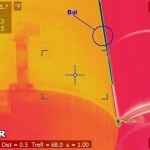 Sometimes, just sometimes, bits of wisdom find their way into fortune cookies.
Sometimes, just sometimes, bits of wisdom find their way into fortune cookies.
Ten Commandments
If I had gone to school for design, no doubt I would have come across this famous quote from Dieter Rams, one of the most influential industrial designers of modern society. Alas, it has taken me this long to discover his wonderfully succinct description of what is also my own design philosphy: “Less, but better.”
Dieter Rams, as head of design at Braun from the early 60’s into the 90’s, created many of the iconic products of that era, including the record player, radio, calculator and juicer designs we are all completely familiar with today.
Johnathan Ive, designer at Apple, is a big Dieter Rams fan, and it has been pointed out that many of Apple’s products, from their computers to iPods, draw from and are very similar to Rams’ Braun objects. The calculator in the iPhone is almost a replica of the his famous Braun calculator. Continue reading Ten Commandments
ben
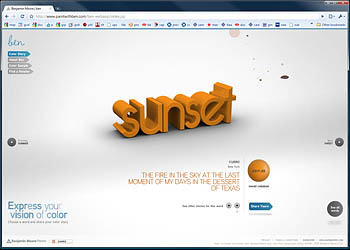 A wonderful example of great web design, both visually and interactively.
A wonderful example of great web design, both visually and interactively.
Great look, and great feel.
I even submitted a word-color-story of my own.
This is what I am aiming towards in my work.
Created by AKQA.
Thanks to Evolve for posting this inspiration.
Cobblestones
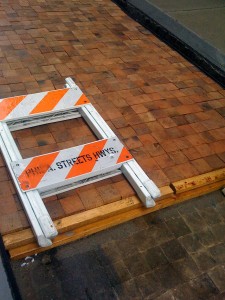 Supposedly unique in the USA, Camac Street between Walnut and Locust is paved with wooden cobblestones.
Supposedly unique in the USA, Camac Street between Walnut and Locust is paved with wooden cobblestones.
Single-lane Camac street is also known as “Avenue of the Artists”. Historically it was home to many important artist clubs and organizations, such as the Philadelphia Sketch Club, started in 1860 and led by Thomas Eakins.
It is surmised that the street was paved with wood instead of the traditional stones or granite belgian blocks to help mute the sounds of the horses’ hooves as traffic passed by the artist gatherings.
These square blocks of wood were re-discovered in the late 1980’s during a street resurfacing project, and the city decided to repave this one section with wooden replicas of the originals.
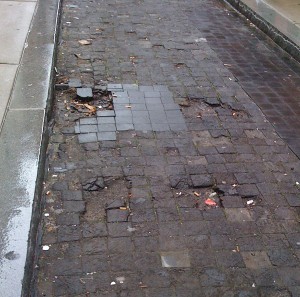 The wooden blocks are currently being replaced, which needs to happen every several years, as they begin to disintegrate and rot. Wooden block streets are attractive, but not enitrely practical.
The wooden blocks are currently being replaced, which needs to happen every several years, as they begin to disintegrate and rot. Wooden block streets are attractive, but not enitrely practical.
It should be pointed out, however, that asphalt also requires replacement or resurfacing relatively often.
Though there don’t seem to be other preserved or refurbished streets like this in this country, wooden cobblestones can be found in historical sites around the world, from Prague to Havana.
Micro Sculpter
 Willard Wigan is an incredible artist from the UK who creates tiny sculptures, usually literally in the eye of a needle or on the head of a pin. The sculptures, which range in subject from pop culture characters to historical objects, are almost invisible to the human eye.
Willard Wigan is an incredible artist from the UK who creates tiny sculptures, usually literally in the eye of a needle or on the head of a pin. The sculptures, which range in subject from pop culture characters to historical objects, are almost invisible to the human eye.
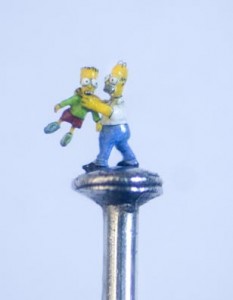
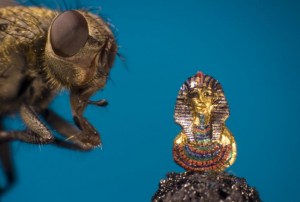 Wigan uses human, rabbit, fly and other hairs as his sculpting tools, creating brushes of different sizes. His website says that to create his miniature works, he “enters a meditative state in which his heartbeat is slowed, allowing him to reduce hand tremors and sculpt between pulse beats.” He says he does not enjoy the work itself, but enjoys the products when he is done.
Wigan uses human, rabbit, fly and other hairs as his sculpting tools, creating brushes of different sizes. His website says that to create his miniature works, he “enters a meditative state in which his heartbeat is slowed, allowing him to reduce hand tremors and sculpt between pulse beats.” He says he does not enjoy the work itself, but enjoys the products when he is done.
Because of this, and the length of time each piece takes, originals are extremely rare, and are sold in a special glass viewing cube that includes a microscope. The works also tour on exhibition, under large insurance policies.
Visit his website to see more www.willard-wigan.com. (Via)
Immense Distances
“Man has invaded space — not in airplanes which would fall to pieces with age before Earth’s near neighbors were visited, but with thoughts which travel faster and work more miracles even than the light of the sun.”
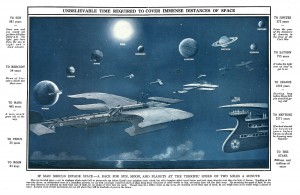
From a 1918 encylopedia of sorts, for children, this beautiful poster does a great job of illustrating the concept of the relative enormity of space. There is a lot of information here, presented in a very accessible design.
The spaceships themseles are whimsical but not entirely unlikely creations, amalgams of several different types of ships and planes, which seem to be leaping into space directly out of the ocean and into a map of our solar system.
The notes and captions around the sides of the drawing help paint the picture of the scale of this map (though using a now-common speed of around 120 mph — 2 miles per minute) with references to well-known historical happenings.
Still a useful teaching tool. Good design withstands the test of time.
Originally scanned in by Azrael Brown, much commented on here, and brought to my attention by John Nack.
Just Two Buttons
The iPhone can take a screenshot! It has been able to since the 2.0 firmware upgrade, but I didn’t know until I stumbled across it and took a screenshot quite by mistake. And didn’t even realize I had done it until it showed up in my camera roll.
 To do it you hold down the home button, then press and release the sleep/wake button. The screen flashes, and the snapshot is stored with your pics.
To do it you hold down the home button, then press and release the sleep/wake button. The screen flashes, and the snapshot is stored with your pics.
Interesting that they chose to dedicate this button combo to taking a screenshot. With only two buttons, there are a limited number of functions that can be physically triggered.
Having only two buttons (and the sleep/wake button is almost hidden itself — took me a month or two to discover it) makes for a very nice streamlined design. But I would give it up and add an ugly button if it would let me cut and paste…
This was one of my main quibbles with Apple’s design — the loss of functionality in the name of design. Such as no right-click on the mouse (mitten mouse, I called it). But, having not used Macs since 1997, little did I know that for the past four years, their mice have had right-clickability. You just can’t see the two different buttons, they are sensors under the single shell.
Turns out the iPhone snaps screenshots itself, all the time, in order to create the aesthetically pleasing “shrinking” of the screen back into the homepage. Some deem this a security flaw, and apparently police have harvested these screenshots to use against arrested suspects.
Fast and Easy
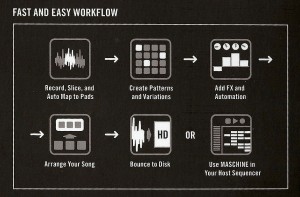 This graphic of icons better describes what the incredible new groove box Maschine does than all the words about it on their box, online, or in manuals.
This graphic of icons better describes what the incredible new groove box Maschine does than all the words about it on their box, online, or in manuals.
A true example of great design by Native Instruments.
Bat-ronaut
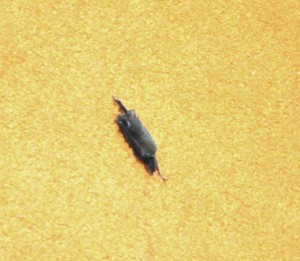 Tangentially design related, but a follow up to my previous post about the International Space Station: Apparently a free-tailed bat was a stowaway on the fuel tank of the Discovery shuttle mission that made the recent delivery to the ISS.
Tangentially design related, but a follow up to my previous post about the International Space Station: Apparently a free-tailed bat was a stowaway on the fuel tank of the Discovery shuttle mission that made the recent delivery to the ISS.
It held on as rocket boosters fired and held on as the shuttle headed up above the launch tower. It is thought to have eventually been shaken off and incinerated. (A bat expert who inspected the pics after the fact postulated that it had a broken wing, and so couldn’t fly away sooner.)
After the bat was discovered during pre-flight walkthroughs, shuttle engineering did debris analysis on him and ultimately a waiver was written to accept the stowaway and allow the launch to continue as planned.
This was reported on the news at the time but I missed it. Aww. Poor bat. But great that the sensors and monitoring of the shuttle takeoff can notice such a miniscule thing. Can’t wait for 2001-like space flights. I hope in my lifetime. I hope.
UPDATE: Images now link to larger versions…
Better Than a Window
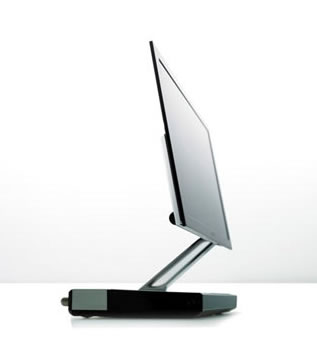 Wow. The new Sony OLED TV has impressive specs and garnered a lot of press, but you have to see it in person to really experience the jaw-dropping clarity of the moving image it displays.
Wow. The new Sony OLED TV has impressive specs and garnered a lot of press, but you have to see it in person to really experience the jaw-dropping clarity of the moving image it displays.
It is currently on display (and available for purchase, just $2,499) at the Sony Style | Comcast Labs cool place (I mean, store) below the Comcast Center at 17th and JFK.
The Organic Light Emitting Diodes have a million-to-one contrast ratio and produce incredible color.
Looking at it is not like looking through a window. There is no glass in the way. Look through the little 12″ frame and you see what appears to be reality on the other side. Go check it out.

